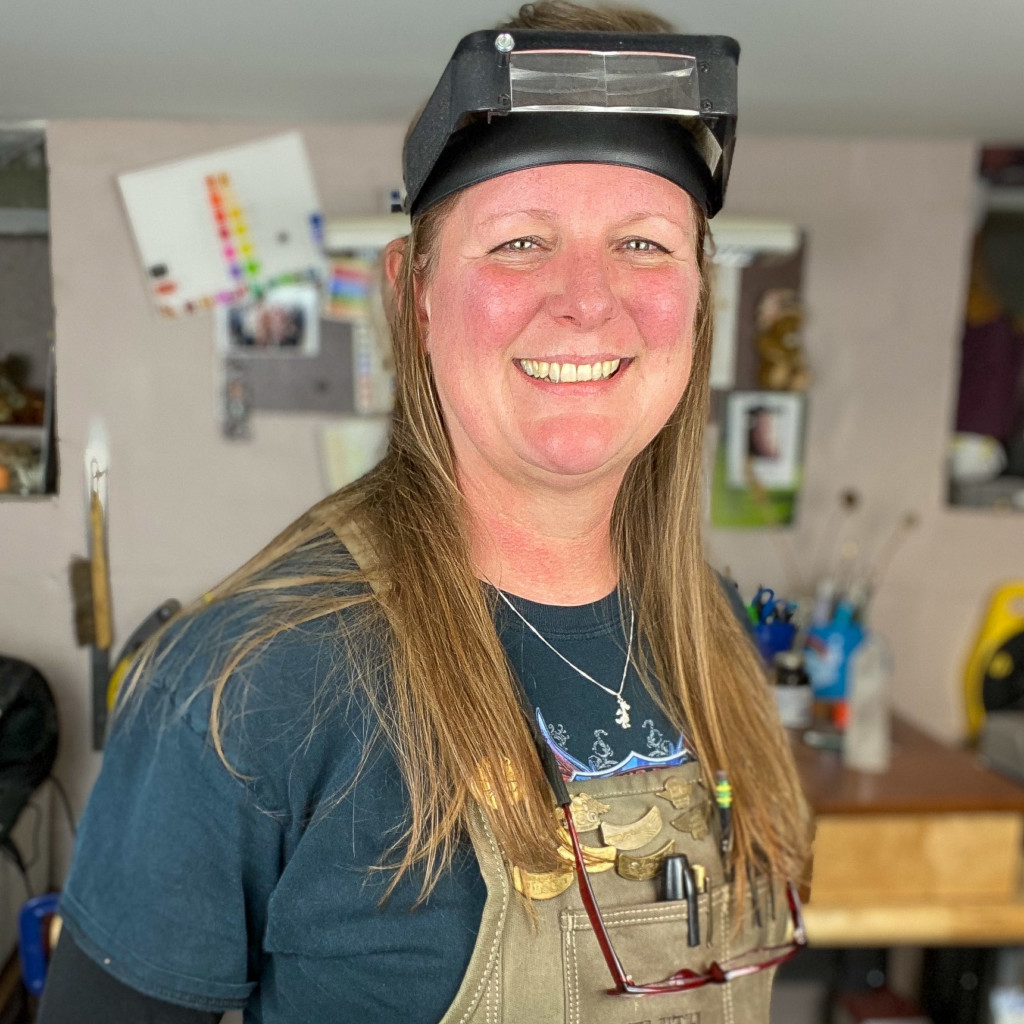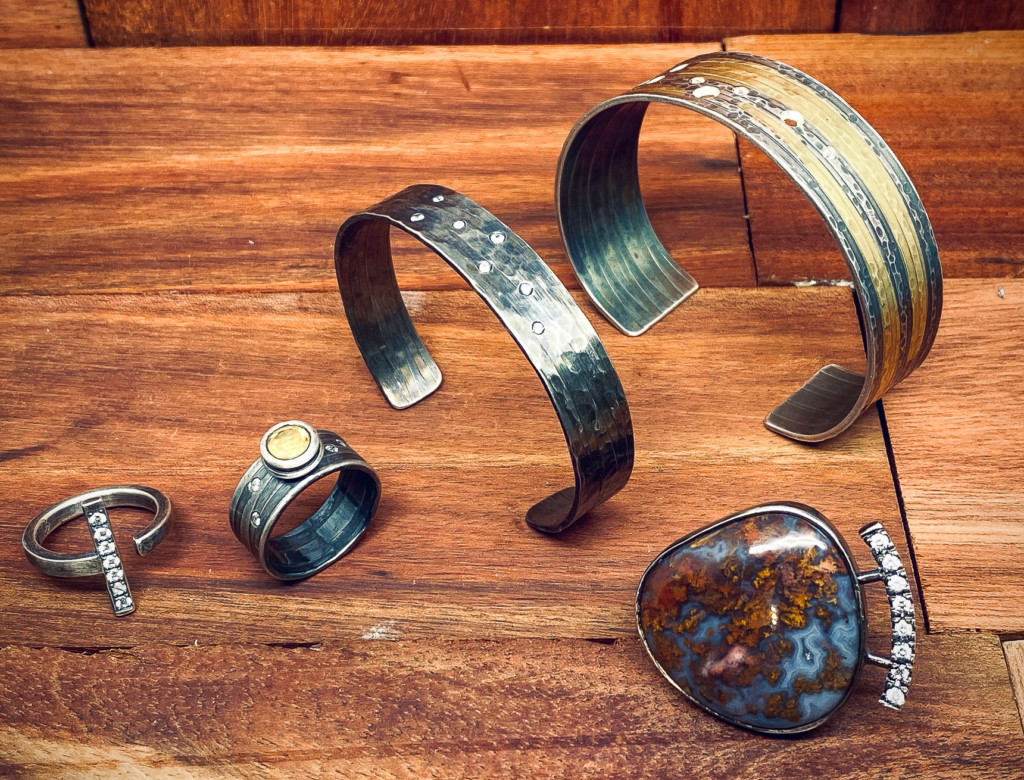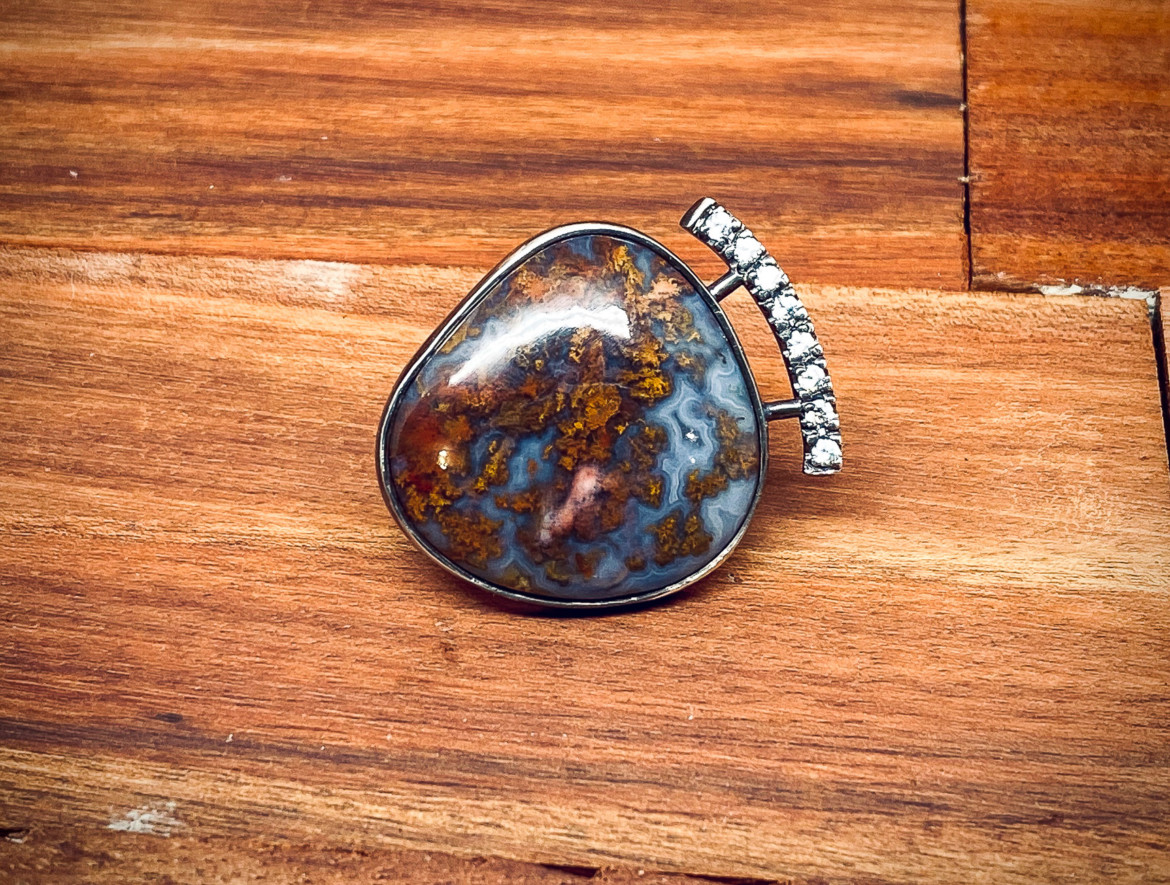By Nina Tabios
Julessa Barnes, a 2019 online graduate from the School of Jewelry & Metal Arts, was on a steady path into the metal arts community well before she graduated from Academy of Art University.
Her thesis collection, called “Identity,” won the attention of coveted metalsmiths as it was featured in several exhibitions, including the Society of North American Goldsmiths (SNAG) in 2018 and in 2019 and the Raleigh Fine Arts Society which included her work in the North Carolina Artists Exhibition, hosted at Contemporary Art Museum (CAM) of Raleigh.
Barnes, who lives in Lincolnton, North Carolina, was on her way to making an impactful resurgence in her jewelry career. But after graduating, she realized she needed a break.
“It was just supposed to be a month, maybe two,” Barnes said. “But, no. Every time I came down here thinking that it was time for me to come back to work, I just didn’t feel it. I kind of trust my gut on that, just like when I’m doing my artwork.”

And a break was just what she needed to reinvigorate her passion for her craft. Art U News caught up with Barnes on what she’s been up to lately and how a little rest and relaxation inspired her to kick off the next chapter—and collection!—of her career.
You took a bit of a well-deserved break after graduation. What did you do and where did you go?
I bought a motorcycle six years ago, and I haven’t been able to really ride it all that much because four-and-a-half of those years I was in school. So I have a group of friends, some elderly gentlemen who are like 65 to 70 years old that we ride with on occasion, and we all decided that we were going to try to pack gear on the motorcycles and go camp for a whole week up in the Blue Ridge Parkway, [which stretches from Virginia to North Carolina]. It was such a great idea—one of the other guys suggested it, he said, “Let’s pick a camp spot where we can bring the motorcycles, stay for four or five nights, and then every morning when we get up, have breakfast and then just take off and ride for the day.”
These guys are my dad’s age and we just have a ball. All we did in the camping trip was find these tiny roads on the map that no one had probably hadn’t heard of—we’d just find one on the map and say, “We’re going there.” These little roads led us to the most beautiful scenery I had ever seen. And we [would] get back in the evening time and start the campfire and just sit around the campfire and give each other a hard time.
Was that the rest and relaxation you needed?
What better way to decompress from four-and-a-half years of straight work, work, work, work, work. And then mix in the selling of two houses, buying a house, moving, starting a business, closing a business. So, by the time this graduation came around, I was so ready for just a break. I basically did nothing but ride motorcycles and run around the mountains from June until about late October. November, December, of course, were the holidays. And January 1, we have our last ride of the season before the spring comes. So, January snuck in, and from then through today, it’s been a whole different ball game. I’ve been working nonstop.
You recently started mentoring, both through your own independent program and the Metalsmith Mentors. How did those opportunities come about?
Friends of mine who were previously students in the studio, we have weekly studio dates and we hadn’t had one in months because I was off running around on a motorcycle. We all met up together and had lunch one day, about mid-January I’d guess, and the girls were like, “You really should be teaching. Yes, your artwork is fantastic and your skills are great, but you are such a great coach and such a great mentor and you know so much about what you do. And you can hear that passion in your voice. You really need to teach people.” So, I resisted it for a couple more weeks and then I finally said, “You know what, it’s time.”
I’m calling my own program the “Online Metalsmith Mentoring Sessions,” which people can find through my Patreon. They are one-on-one to start with and they can video chat with me, and [I can] see very specifically what their questions are about the work that they do. And if they want to see a little mini demonstration, I’ll move my little iPad with my camera over to my bench and give them a little demonstration or if they want to show me something they’ve been working on they can put it on the live meeting and have a real-life interactive class where they don’t have to leave the comfort of the studio.
As for the Metalsmith Mentors, I found them while I was in this six-week Instagram program where part of it is research your competitors for the business plan you have in your head. I didn’t find any true competitors except for them. I start perusing through their website and I wound up seeing Charles Lewton-Brain, John Cogswell, Andy Cooperman—all these big-name people who are my idols and mentors in the metal art jewelry world. When I saw it, I kid you not, the website had just launched the day before, so it felt fortuitous and meant to be. I filled out an application to be a mentor and shortly after that, there was a spike on my website, looking at my bio, my portfolio, my résumé, which I made in my Professional Practices class at the Academy.
What was your reaction when you found out you were accepted?
Maybe a week later, I got the email notification that I had been accepted as a mentor. And I thought, “Holy cow! This is crazy.” They consider me experienced and artistic enough to be up with the likes of [Charles] Lewton-Brain, Betty Helen Longhi, John Cogswell. I was down here doing cartwheels I was so excited. That was a real ego booster and when I was talking to Karen [Chesna] about this last week, she’s like, “You know, doesn’t it feel good to feel like you’re part of that world now?” And she goes, “If you hadn’t had the master’s program, you probably would not have thought or been at that point.” And I said, “You’re absolutely right.” I credit my decision to go to school and get that master’s degree to get me where I am right now.
How did you start incorporating social media into your craft and business?

I was scrolling through Instagram and this advertisement came up for what was called, “An Instagram Makeover.” It was a six-week program by a woman named Kat Coroy. She was apparently a marketing and graphic designer for big companies like Coca-Cola. She’s very into finding what she calls, ‘your brand soul essence’ and basically it was a six-week class that took you step-by-step through kind of an exploration into who you are and what you want your business to be. She had you think about how you want to make people feel when they are working with you and your business and then how to translate that into graphic design and marketing and social media, specifically Instagram. It was almost like an exercise in creating a collection of work [as] I did for my thesis.
What were some of the key points you learned from this program?
Instagram has become my business funnel and what I’ve learned from the Kat Coroy program is the idea behind presenting this authentic business. Meaning, I’m presenting me and hoping that I find or attract a tribe of people that I want to be involved with what it is that I do. It really got me to think about who I am as an artist. The ultimate goal is getting your brand statement out there and to figure out how to design that page aesthetically so when somebody looks at your Instagram, they see a cohesive collection of images and then it makes them want to stay on the page and see what you’re about. She kind of has you do those little emotional journeys about feelings and what those feelings might look like in colors or shapes or backgrounds and foregrounds.
In addition to that, I’ve been shooting Instagram TV episodes that talk about me and who I am, that way If I’m going to do a mentorship online with people one-on-one, they’re going to want to know who I am and see if we might not jive or if we will jive. After that, I started putting out some how-to videos, like, “Here are some tips and tricks on how to use your hammer the correct way” or “the best way to get a finish on the end of your jewelry piece.” The possibilities are endless.
Along with mentoring, what else are you working on?
Since I ride motorcycles, there are lots of women who ride motorcycles and they’re always asking me for jewelry. What a great way to kind of find a tribe of women who ride motorcycles; three out of four people buying new motorcycles are women. And they like fancy, blingy, shiny, big, bold crazy jewelry because they want to look like a badass when they’re on a motorcycle. So, there aren’t really any women’s jewelry lines out there for motorcycles. So, that’s my next goal. [B]reak out a line of jewelry that has my aesthetic to it, that has this mixed media, mixed material, but a retail version that would sell to motorcycle chicks, because that’s who I’m around all the time. And they’re always asking me, “Do you have that with a bunch of diamonds all over it?” or “Can you do that in gold?” And I’m thinking, “Heck yeah, I’ll do it in gold because that’s a lot more money for you and me!”
How do you balance everything, between working on your own jewelry line, mentorship, and managing your social media presence?
The initial work is hard. But there are a lot of apps to help you do it. I learned them all through the Instagram program, which is jam packed with so much information it’s kind of overwhelming. But since I signed up for her class in February, I’ve spent every day, except maybe a handful, working nonstop to develop my color scheme, my brand colors to integrate all of those things she taught me about Instagram on my website, on my YouTube channel, on my thumbnail covers, on my product covers. I still have a lot more work to do but at this point right now I’m promoting all my mentoring before I promote the jewelry. The jewelry requires more physical effort at this point. Eventually, I want to go back to selling and going to the art shows and submitting things to the museums and galleries and back to that art school look and feel because really that’s where I belong. It’s been really hard. But I have a feeling it’s going to be so worth it.
What is your advice for students who want to use social media to promote their work and themselves as artists?
I would say, take a second look at yourself inside. What is your objective? Who are you trying to interact with on social media? It’s called social media for a reason. You want to make connections. You want to develop partnerships and possibly do collaborations later on down the road and you can’t do that if 7,000 of your subscribers are just giving you hearts, and they never talk to you. So it’s important to establish that community relationship with the people that would be, I call it my “tribe,” because I’m looking for like-minded people to be my followers. I’m more concerned [about] building my business, not my reputation. Because if I build my business and I have hundreds of clients, then my reputation is out there.
This interview has been edited for length and clarity.
